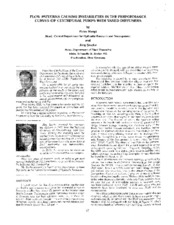| dc.contributor.other | International Pump Users Symposium (2nd : 1985) | |
| dc.creator | Hergt, Peter | |
| dc.creator | Starke, Jorg | |
| dc.date.accessioned | 2017-10-05T22:45:11Z | |
| dc.date.available | 2017-10-05T22:45:11Z | |
| dc.date.issued | 1985 | |
| dc.identifier.uri | https://hdl.handle.net/1969.1/164363 | |
| dc.description | Lecture | en |
| dc.description | pg. 67 | en |
| dc.description.abstract | It is well known that backflow regimes at the impeller inlet can lead to performance instabilities for centrifugal pumps at flowrates smaller than about 65 percent of the impeller inlet design flowrate. Performance curve instabilities can also occur at flowrates near the best efficiency point, i.e., at about 75 percent of the optimum flowrate. This is true for a special class of pumps, namely centrifugal pumps with vaned diffusers and specific speeds greater than 30 min⁻ ¹. In connection with this type of instability, the axial forces are considerably changed, with the instability itself depending on manufacturing tolerances. A Reynolds-number effect, however, is not present. The instability is caused by a very complicated three-dimensional flow structure inside the diffuser channels. The resulting backflow into the impeller is directed against the impeller rotation. Modifications of the diffuser vane leading edges based on two-dimensional flow models do not help to avoid the instability. | en |
| dc.format.medium | Electronic | en |
| dc.format.mimetype | application/pdf | |
| dc.language.iso | en | |
| dc.publisher | Turbomachinery Laboratories, Department of Mechanical Engineering, Texas A&M University | |
| dc.relation.ispartof | Proceedings of the 2nd International Pump Symposium | en |
| dc.subject.lcsh | Pumping machinery | en |
| dc.title | Flow Patterns Causing Instabilities In The Performance Curves Of Centrifugal Pumps With Vaned Diffusers | en |
| dc.type.genre | Presentation | en |
| dc.type.material | Text | en |
| dc.identifier.doi | https://doi.org/10.21423/R1X98S | |


